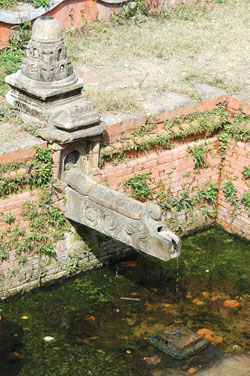 MIN BAJRACHARYA |
Then parliament passed a bill to lease management of the capital's drinking water system to a private operator in January, and even though it wasn't yet validated by the speaker, it created an uproar.
To look for answers to Nepal's urban water supply crisis, we need to go back to the murder of Ranodip Singh in the 1880s by his own cousins. This heralded the demise of the Jungs and rise of the Sumsheres. Prime Minister Bir Sumshere Rana summoned a British engineer to build a drinking water system in Kathmandu to expiate his sins.
Bir Dhara Works, which was completed in 1891, also served Phora Durbar, then a Rana palace. Modern technology had made inroads into a medieval kingdom as an item of luxury. At that time in the UK, private companies had already started making profit by serving piped drinking water to citizens.
Bir's successors, Chandra and Bhim, added more water to the system. Many foreign aid agencies supported expansion of the system after the 1950s. In the early 1970s, the World Bank became the main actor in managing Kathmandu's water supply and pumped in Rs 756 million in two decades. The Melamchi Project was selected as an option for Kathmandu's increasing needs in the mid-1980s. In the heydays of post-referendum Panchayat polity, the clich? was that Melamchi's clear water would flush the filth from the Bagmati. Later, leaders boasted they would wash Kathmadu's streets with Melamchi water.
In 1987, the then-government assigned Rastriya Panchayat member Birendra Keshari Pokharel to head a commission to study the water supply and sewerage situation in the main cities. His report showed poor quality of services, fiscal incontinence, and institutional haemorrhage. It recommended that management be decentralised, leakages controlled, municipalities brought in, and a Pubic Utility Commission formed to hedge tariffs. Both the World Bank and the government ignored these recommendations.
Despite known institutional dysfunction, donors and the government continued to pump millions of rupees into the corporation. It was supposed to be autonomous but was a defacto government outfit. Its 1989 Act stipulated that the corporation should 'comply with (government) directives'. Genetically, the corporation was designed to suit political manipulation and rent-seeking, and became a medium for dispensing patronage. In the mid-1990s, it was twinned with a British private water company to help build its management capacity. The program's review in 1995 showed that very little had improved since 1987. It also recommended fiscal and administrative devolution, but these were also ignored.
The late 1980s saw the emergence of an ideology of corporate globalisation. Western governments and aid institutions imposed it as a panacea for nascent democracies, including Nepal, instead of helping nurture a plurality of approaches to build competitive markets that would be regulated by socially-rooted institutions. The bureaucracy, adept at co-opting development jargon, remained faithful to its aid masters and became a champion of the free market. Without exploring other institutional modes, the government in 1998 constituted the High Level Private Sector Participation Committee to pave the way for a private operator to manage Kathmandu's water supply.
By the mid 1990s the World Bank was dithering and a few years later would withdraw from the urban drinking water sector. In a 2002 interview with Nepali Times its Nepal representative, Ken Ohashi, admitted that the Bank's investment had been flushed down the Bagmati.
Asked 'What about Melamchi? Why are you not involved?', Ohashi replied: 'This is not a popular position in Kathmandu, where many people view Melamchi as the solution to all their water problems. We believe that important options have not been explored to utilise the water resources available within the Valley'. He also raised questions about Melamchi crowding out priority projects and equity concerns from a national perspective. Both questions have remained unanswered.
In a classic display of donor competition, the Asian Development Bank jumped in to fill the vacuum.
The story put out about a private water service provider in Kathmandu is a compilation of pious statements about how the world ought to be. But were alternatives piloted and lessons documented for up-scaling in the last ten years, or was the selected mode pushed as the only alternative? How should Nepali organisations be reformed?
Recent thinking on the governance of natural resources suggests that a mix of institutional styles-government, market, community initiatives-is necessary for the policy terrain to remain dynamic and stable. Competition, not selection of one institutional style, contributes to efficiency.
The decision on the nature of the mix is a political one, which is why Nepal's interim parliament must enter the debate by first educating itself of past mistakes and examining alternative ways to provide citizens with basic services such as drinking water. Then it can propose principles for a re-structured Nepal.
Ajaya Dixit is a water analyst with Nepal Water Conservation Foundation.



